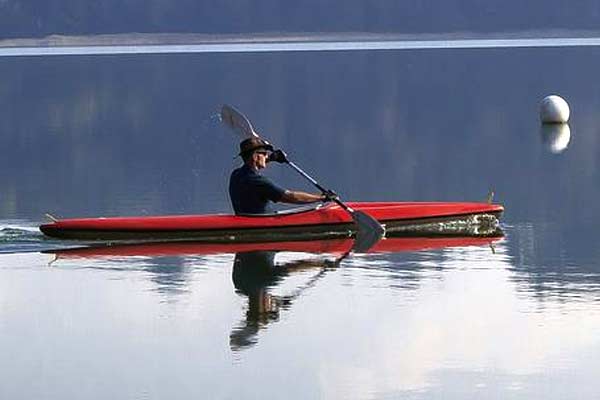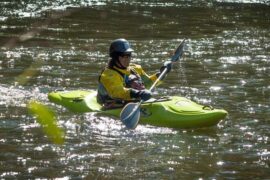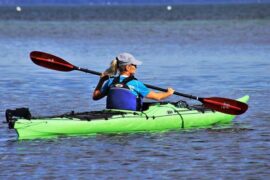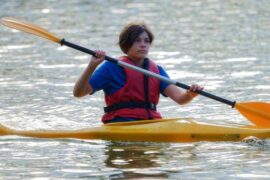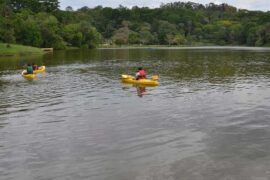Kayaks vs. Paddleboards: the Turtle and the Hare
On a hot summer day, there’s nothing better than hitting the water in your kayak or paddleboard. Both are excellent ways to get back to nature and get a workout.
There’s a good chance you’ll hit the water, too. But if you want to go fast, which is the best choice?
The kayak is generally the winner for speed when it comes to paddling in a straight line. It offers more stability than the paddleboard, which allows the rider to use more powerful strokes, increasing speed. You’re also less likely to tip over in a kayak, giving you more time paddling than trying to upright your vessel. Because of all these factors, kayaking is faster.
Which is Faster, the Kayak or the Paddleboard?
Generally speaking, the kayak will be faster than the standup paddleboard. However, they both have a variety of shapes designed with specific purposes in mind. The kayak usually comes out on top when paddling in a straight line.
Differences Between a Kayak and a Paddleboard
There are several differences between the two that affect their speeds. Depending on how these differences affect the rider, they will also impact the speed at which the vessel travels.
Stability and Speed
Kayaks offer far greater stability than paddleboards. This is because the center of gravity is kept far lower, enabling easier balancing. It requires much more movement to tip it over than a paddleboard. This stability allows for much more intense strokes and greater speed.
On the other hand, the paddleboard requires you to stand while operating it. The center of gravity is elevated, making it harder to balance. This positioning causes you to paddle slower to maintain your balance and, in turn, go slower.
Staying Upright
Another aspect that allows the kayak to move at a faster speed is its ability to stay upright. It does not flip as often as a paddleboard, keeping you moving forward. Although, it is a bit more challenging to get back into a kayak than to remount a paddleboard.
Because of their lack of stability, you’re more likely to flip your paddleboard until you gain mastery over your balance. With all this starting and stopping, you will move a lot more slowly.
The Effects of Fitness on Speed
When you use a kayak, you will target the muscles in your core and arms and perform a cardio activity. Because you are sitting, you will not be using your legs.
On the other hand, the standup paddleboard targets all the muscles in your body. You stabilize yourself with your legs and core while propelling yourself with your arms.
The average-level fitness user will go much faster in a kayak than on a paddleboard.
How Fast Does a Paddleboard Travel?
You won’t be expected to move fast on a paddleboard unless you’re racing. Average speeds on a casual ride are between 3.5 and 4.5 mph. It’s comparable to jogging speed to give you a general idea of how fast that is.
That doesn’t mean you’ll be stuck at 5 mph forever. With improved skills will come faster speeds. Many racers can achieve up to 7 mph with records beating that average speed.
How Fast Can a Kayak Travel?
Different designs affect the speed of a kayak. However, for a basic recreational kayak measuring 12 feet long and 30 inches wide, most kayakers will maintain an average speed of 2 to 5 mph.
Which Is Easier to Paddle?
Generally speaking, it is easier to paddle a kayak. They move faster than paddleboards, perform better in whitewater and open seas, and are usually easier to maneuver.
Is a Longer Paddleboard Faster than a Shorter One?
The length of your paddleboard will make a massive difference in determining how it handles. Generally speaking, longer boards will move faster than shorter boards; however, shorter boards can be maneuvered better. These are things to keep in mind:
- Shortboards are ideal for surfing and kids.
- Medium boards are perfect for all-around use, including paddleboard yoga.
- Longboards are suitable for paddling fast and touring long distances.
What Influences Speed?
Several factors influence the speed and whether you use a kayak or a paddleboard.
Environmental Conditions
Choppy waters will slow you down. Moving in tranquil waters will allow you to move more quickly in whatever direction you want to move in.
The same thing goes for the wind. If you are moving with the wind, you may move more quickly, but you slow down when you try to move against it.
User Skill
The more skill you have at paddling, the more speed you will likely have. You will need to know the right kind of posture and paddling techniques, whether you are using a kayak or a paddleboard.
Experience
If you’re a new rider, you’ll be slow as you figure things out. As you gain experience, you’ll add speed. Don’t worry if you’re the slowest one on the water when you first start; everyone has to start somewhere.
Craft Design
The design of your kayak or paddleboard will also affect how fast you move. As discussed above, longer paddle boards will move faster than shorter ones. Kayaks with slimmer, narrower designs will also move faster.
Conclusion
Enjoying the water in your kayak or paddleboard can be a great way to experience nature. With the breeze in your hair and the sun on your face, it’s one of the best experiences. It’s also a fantastic way to get a workout without being stuck in a gym.
If you want the fastest option, chances are you want a kayak. For straight-line paddling often beats out a paddleboard. With its excellent stability and ease of staying upright, the kayak has fantastic features that boost its forward speed.
